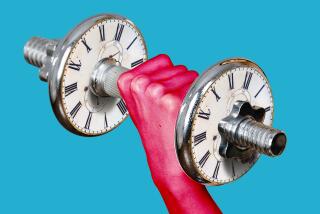Experts Ease Up on Rules for Exercise
- Share via
Getting fit doesn’t have to be time-consuming, according to new guidelines released last month by the American College of Sports Medicine. Ten-minute exercise bouts can significantly boost health, note the recommendations, which update guidelines issued in 1990. And when it comes to building muscle, performing just one set of weightlifting exercises (eight to 12 repetitions) is just as beneficial for most adults as a multiple-set regimen.
To decide “how much exercise is enough,” consider a person’s “needs, goals and initial abilities,” the group’s experts advise. Then, use “a sliding scale as to the amount of time allotted and intensity of effort” required.
In a culture in which most adults get little or no exercise and half the people who start a program quit within six months, exercise adherence is one of the toughest issues facing those trying to jump-start sedentary Americans. This is one reason the new guidelines carefully avoid rigid, “one-size-fits-all” advice. Instead, they advocate creating “a program for the individual to provide the proper amount of physical activity to attain maximal benefit at the lowest risk . . . and encourage a lifetime of physical activity.”
While you can still get health benefits from doing less exercise than these guidelines recommend, adults who want to achieve optimal fitness are advised to participate in a well-rounded program that includes:
1. Aerobic exercise (such as walking, stair climbing, cycling or swimming) three to five days a week, at 55% to 90% of the maximum heart rate, for 20 to 60 minutes, either working continuously or intermittent bouts of at least 10 minutes each. The higher intensity the exercise, the shorter the workout necessary to achieve cardiovascular benefits. But since high-intensity exercise is often associated with injury and adherence problems, the guidelines advise “moderate-intensity activity of longer duration . . . for adults not training for athletic competition.”
2. Resistance exercises (such as lifting weights or using a strength-training machine) two to three days a week. Do one set each of eight to 10 exercises that strengthen the major muscle groups: arms, shoulders, chest, back, abdominals, hips and legs. Most people should pick a weight heavy enough for them to lift at least eight, but no more than 12, times. Older and more frail people (about 50 to 60 and older) may find it more appropriate to choose a lighter weight they can lift at least 10, but no more than 15, times. While one set of each exercise is sufficient to boost strength and prevent loss of muscle mass in most adults, the guidelines note that three-set regimens may provide slightly greater benefits if time allows.
3. Flexibility exercises that stretch the major muscle groups a minimum of two to three days a week. For the first time, the organization is recommending stretching exercises to enhance performance, improve joint range of motion and help prevent injury.
*
Another way to get enough exercise is to do activities that burn between 1,000 and 2,000 calories per week, said Michael Pollack, lead author of the guidelines and director of the University of Florida’s Center for Exercise Science until he died of a stroke at 61 during the organization’s annual meeting in Orlando, Fla., last month.
For health benefits--such as reducing the risk of numerous chronic diseases--do an activity that burns 150 calories on most days of the week, Pollack said in an interview June 4, the day before his death. For fitness benefits--such as greater endurance and strength--expend 250 to 300 calories per workout, three to five days a week.
Activities that burn about 150 calories include: washing and waxing a car for 45 to 60 minutes, gardening for 30 to 45 minutes, social dancing for 30 minutes, swimming laps for 20 minutes, jumping rope for 15 minutes or stair climbing for 15 minutes.
Activities that burn about 250 to 300 calories per workout include: running at a 10-minute-mile pace for 30 minutes, walking at a 15-minute-mile pace for 50 to 60 minutes, playing basketball for 30 to 40 minutes or bicycling eight miles in 30 minutes.
*
“The average person shouldn’t train like an athlete because it’s too stressful,” Pollack said. “In general, people shouldn’t do strength-training sessions or high-impact activities two days in a row. It’s better to space out hard workouts, so that you rest or do low-impact activities on alternate days.”
Don’t expect to shape up overnight, Pollack cautioned. Going from sedentary to “in shape” will take a young person about three to five months of training, he said, and an older person about six months to a year.
“But if you’re going through a busy period, even one quality workout a week can help maintain fitness,” he said. “The important thing is to just get out there and do it.”
*
Fitness runs Monday in Health.






